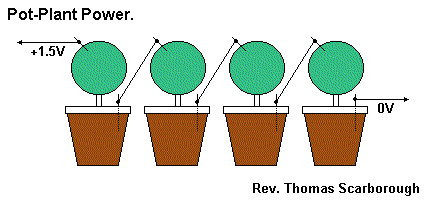Pot Plant Power
Following a hunch, the author discovered (or re-discovered?) that all plants carry an electric charge relative to the ground. This charge is more or less constant regardless of the size of the plant - a kind of "background voltage" in nature. This electric charge suffuses the entire plant, from its roots to its leaves and fruit. It was measured between a chrome-plated pin inserted into the plant (the positive terminal) and an iron spike driven into the ground (the negative terminal).
A number of explanations have been suggested in discussions:
� That the plant itself generates an electric charge to control its various functions.
� That the plant is picking up electromagnetic waves from power pylons or radio transmissions. Or
� That the pin and iron spike are generating a small voltage by means of electrolysis.
At any rate, the voltage present in plants may be harnessed to power a highly efficient circuit such as a "potato clock". This is done by wiring four or more plants in series. Garden plants, of course, share a common earth, and cannot therefore be wired in series. However, the author found that pot-plants can be wired in series, since each has a separate earth (see Fig.1).
When electrical energy is tapped from a plant, the voltage in the plant drops about 20% within half a second, then settles at around 400mV, while current settles more slowly to one or two �A d.c. D.c. current may be increased by wiring together a few positive terminal pins across the same plant.
A curious feature noted by the author is that plants generated a variable a.c. waveform of a few kilohertz. This could also have a number of explanations. Do contact the author if you have any interesting experiments or new observations (see the e-mail address at the top of this article).

